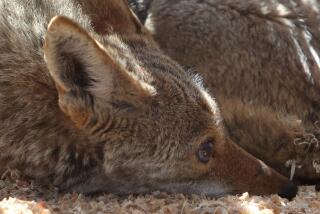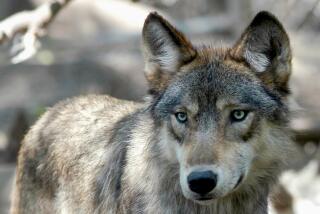Smuggling brings down Texas deer breeders
Texas’ hunting season for white-tailed deer draws to a close this month. Normally Billy Powell would be counting his profits from catering to “hornographers,” hunters who will pay as much as $100,000 to bag a monster buck with impressive headgear.
Instead, the 78-year-old deer breeder is under house arrest and wearing an ankle monitor.
Meanwhile, hundreds of his deer, part of a herd that had included two big bucks named Hit Man and Barry, have been put down in a scandal that has rocked Texas’ $2.8-billion deer hunting and breeding industry, the largest in the nation.
Powell is one of 1,236 registered Texas breeders. Some have paid up to $1 million for first-rate bucks they mate with captive does. Their progeny, 103,155 registered this year, are raised in pens and released on high-fenced ranches before the start of hunting season, which runs from October to late January.
But Hit Man and Barry were smuggled into Texas from northern states where two deer diseases are found.
After a four-year federal investigation, Powell paid $1.5 million in fines and restitution and pleaded guilty to charges of smuggling more than three dozen white-tailed deer worth more than $800,000 from Illinois, Indiana, Ohio and Pennsylvania over a three-year period.
Mitch Lockwood, big game director for the Texas Parks and Wildlife Department, said Powell put the state’s 4 million wild deer “and the entire Texas deer breeding industry at risk.”
Powell and other breeders say regulators have become overzealous, out for hefty fines that become their agency’s cut of the burgeoning cervine, or deer, farming business.
“Parks and Wildlife don’t like deer breeders, and they’ll do anything to get you,” Powell said earlier this month, wearing a western shirt adorned with bucks and rifles outside his ranch in New Summerfield, where deer blinds and “Deer Lease” signs punctuate the piney woods. “I did wrong, but they did more wrong.”
Hunters rate trophy bucks according to a scoring system developed by Theodore Roosevelt’s Boone and Crockett Club in 1887, even though the club does not recognize farmed or high-fence hunted deer. The score includes antler length and circumference, with the best Texas white-tails traditionally scoring 150 to 160.
Today, thanks to breeding, mammoth deerzillas are scoring 200 or more.
Breeders say they can sell semen from outstanding bucks for up to $35,000 dollars a sample, or “straw,” to engineer the next generation of Dr. Seuss-worthy antlers.
The breeders advertise pedigreed Texas bucks with storied names and bloodlines like those of racehorses: Stickers, Dinero and Golden Boy.
“It’s like a rock star: The white-tail is the most sought-after animal in Texas,” breeder Roy Malonson said while checking on his herd of 168 deer recently at RS Deer Ranch outside Houston. “We have the challenge to produce that.”
Many breeders rely on artificial insemination partly because Texas outlawed importing out-of-state deer seven years ago to prevent the introduction of bovine tuberculosis and chronic wasting disease, a neurological disorder similar to mad cow disease. Texas has never had a case of chronic wasting, which can be spread by contact, but regulators are concerned because 17 other states have, including neighboring New Mexico and Oklahoma.
Still, some breeders have ignored the ban.
Powell, who made his money running successful nurseries, became interested in white-tailed deer as a hunter, and started breeding them as a hobby at his 5 P Farms in the 1990s. By 2008, his buck Barry, named after Powell’s eldest son, had scored 440 on the Boone and Crockett scale, well above the white-tail world record of 333 7/8.
But Barry was among the bucks Powell had smuggled from Pennsylvania, distinctive enough to draw the attention of regulators. (In Pennsylvania, the buck was known as Fat Boy.) After Powell placed an ad in the Texas Deer Assn. magazine to sell semen from Barry and another monster buck, Hit Man, the investigation began.
Hit Man, it turned out, was actually Silver Storm, a well-known buck from Indiana.
Barry and Hit Man died of natural causes before authorities brought charges against Powell last year, but their presence helped establish the government’s case. Powell pleaded guilty in June to smuggling 37 deer into Texas.
“I brought it on myself,” Powell said.
Karl Kinsel, executive director of the San Antonio-based Texas Deer Assn., said the group has expelled Powell and about 20 other breeders in recent years for smuggling and other violations of its ethics policy.
“This business has gotten so lucrative; we don’t want somebody messing up the ethics of hunting,” Kinsel said. “We don’t like to be considered a bunch of Billy Powells.”
There is no way to test live deer for chronic wasting disease, and Powell had to pay regulators about $28,000 to kill and test his 334 deer in April and May. They mostly dispatched the deer with bolt guns, beheading them to test their brains. It took five trucks to haul away the carcasses.
Regulators also euthanized and tested out-of-state deer Powell sold to breeders. None tested positive for chronic wasting disease or bovine tuberculosis.
Investigators went on to charge Powell’s grandson. Last month, Blake Powell, 32, pleaded guilty to smuggling deer, including bucks Diablo and Thunderstruck, and agreed to pay $400,000. He also had to pay the state to kill his deer, which did not test positive for chronic wasting disease or bovine tuberculosis.
As a condition of their pleas, the Powells are not allowed to breed deer in Texas for three years.
Still, antler fever is hard to shake. Powell reads catalogs advertising Pennsylvania does who “never had a son score less than 240.” But he’s not sure he will ever return to deer breeding.
“All the starch has been taken out of me,” he said.
molly.hennessy-fiske@latimes.com
More to Read
Start your day right
Sign up for Essential California for news, features and recommendations from the L.A. Times and beyond in your inbox six days a week.
You may occasionally receive promotional content from the Los Angeles Times.







